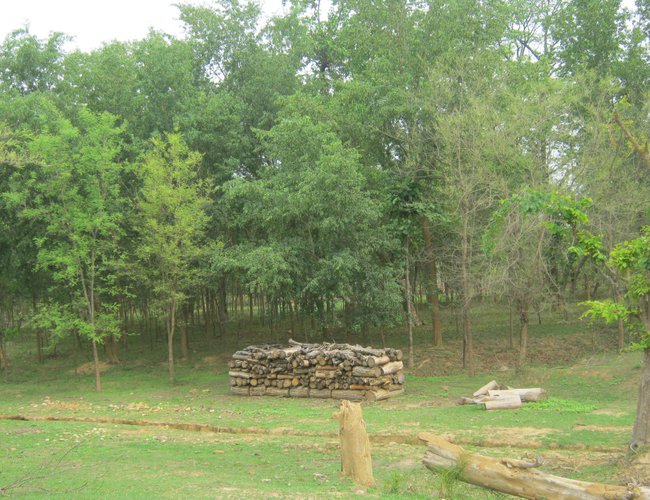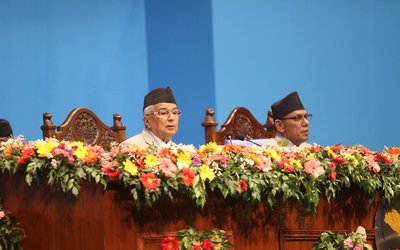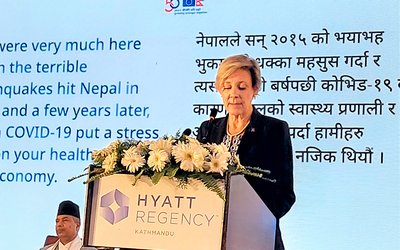
The Climate Change Policy (2019) recognizes, inter alia, the adverse impacts of climate change on ecosystems and underscores the importance of building its resilience by implementing a policy of developing and expanding payment for ecosystem services received from ecosystem-based adaptation (EbA). Adaptations options named as community-based or community-led or ecosystem-based or combined are under implementation to reduce adverse effects of climate change on vulnerable communities, their livelihoods and ecosystems - life-supporting system.
Nepal's National Adaptation Programs of Action (NAPA) approved by the Government in September 2010 prioritized nine adaptation programs for most urgent and immediate adaptation needs. These programs emphasize, inter alia, implementing community-based adaptation (CbA), building and enhancing the adaptive capacity of vulnerable communities, reducing climate-induced disasters, managing forests and ecosystems, and promoting climate-smart urban settlement.
Considering the comparative advantage of the GEF Implementing Agencies, UNDP and UNEP were invited in 2010 to support Nepal in accessing funding from LDC Fund to implement NAPA prioritized adaptation options to reduce adverse effects of glacier melting, and EbA options to restore degraded ecosystems. Implementation of GLOF-related project was completed a few years back, and LDCF-supported EbA project which faced unwanted complexities from GEF and the GoN is now under implementation.
In 2009, Convention on Biological Diversity defined the EbA as the use of biodiversity & ecosystem services as part of an overall adaptation strategy to help people adapt to the adverse effects of climate change. EbA covers sustainable management, conservation, rehabilitation and restoration of ecosystems to build climate resilience by reducing the vulnerability of communities and natural resources to climate change. It enhances ecosystem goods and services.
Adaptation projects in Nepal have addressed and will address climate vulnerability and ecosystem management in different areas. Four dedicated EbA projects have been implemented and/or are under implementation in Nepal. It does not mean that other projects do not consider EbA options. For example, Nepal Climate Change Support Programme and Hariyo Ban Projects under implementation (second phase) with support from UK and US governments include activities to conserve biodiversity, restore habitats, and increase the income of climate-vulnerable people and communities. The TAL and CHAL projects focused on reducing threats to the ecosystem, helping communities to build resilience to the adverse effects of climate change, and improving livelihoods.

Of the four dedicated EbA projects, Nepal was included in two international projects - EbA in mountain ecosystems implemented in Nepal, Peru and Uganda with support from the Government of Germany through UNEP, UNDP and IUCN; and enhancing capacity, knowledge and technology support to build climate resilience of vulnerable developing countries, popularly known as EbA South, was implemented in China, Mauritania (dryland), Nepal (highland) and Seychelles (island) with funding from Special Climate Change Fund (SCCF) through UNEP. In Nepal, mountain EbA was implemented in Panchase (Kaski, Syanja and Parbat) and EbA South in Chiti, Lamjung. These two global projects contributed to developing methodologies and tools for EbA, building ecosystem resilience, reducing the vulnerability of mountain communities, strengthening country capacity, and generating and sharing knowledge, lessons and good practices.
Nepal accessed funding from the LDCF through UNEP to implement two EbA projects - catalyzing ecosystem restoration for climate-resilient natural capital and rural livelihoods in degraded forests and rangelands; and urban EbA for climate-resilient development in the Kathmandu Valley. The forests and rangelands project that is under implementation aims to increase the capacity of the government and local communities to adapt to climate change by implementing EbA options. This project is expected to restore forests and rangelands in the mid-hills of Achham and Salyan and the high mountains of Dolakha districts. The urban EbA project will build the resilience of local communities of the Kathmandu Valley to the increasing threats of climate-induced flooding, landslides, and drought through EbA options.
The urban EbA project is expected, inter alia, to promote groundwater recharge, improve soil stability, and reduce flooding and landslides in the Valley. It will contribute in mainstreaming EbA options into urban planning, documenting knowledge, lessons, learning and best practices, and developing skills. It will further contribute, inter alia, to protecting water sources, developing flood management tools, constructing conservation ponds, recharging groundwater wells, planting climate-resilient tree species, managing open spaces, and minimizing damage from rivers and streams.
UNEP is implementing a regional EbA project to build climate resilience of urban systems in the Asia-Pacific region with the objectives of strengthening institutions and building capacity of city management authorities, demonstrating urban EbA interventions and disseminating knowledge and raising public awareness on urban EbA in pilot cities of Bhutan, Cambodia, Lao PDR and Myanmar. Specific EbA interventions range from reforestation, agriculture and wetland restoration to support the livelihood of urban poor communities.
Nepal's urban EbA project may generate practical lessons and learning, including benefits of EbA options and 'nature-based solutions' in making cities environmentally comfortable living areas and encourage adaptation advocates at national, regional and international levels in developing and implementing additional EbA options.
With support from the Government of Germany, the Global EbA Fund has been established to support scaling up EbA options to reduce climate vulnerability. This Fund is led by IUCN and UNEP. Nepal may wish to develop additional EbA projects and access funding from LDCF, SCCF, Green Climate Fund (GCF), and Adaptation Fund as a Party to the UN Framework Convention on Climate Change, Kyoto Protocol and the Paris Agreement. Funding may also be accessed from the Global EbA Fund, friendly countries, multilateral agencies, and other funding initiatives operated to support the implementation of the Convention, Protocol and Agreement in developing countries. Opportunities exist to reduce adverse effects on climate-vulnerable communities and ecosystems, and to benefit from EbA options, both in urban and rural areas. However, it demands for dedicated efforts.

Batu Uprety
Former Joint-Secretary and Chief of Climate Change Management Division, Ministry of Environment (then), and former Team Leader, National Adaptation Plan (NAP) formulation process. E-mail: upretybk@gmail.com
- Revisiting The EIA Report
- May 15, 2024
- Dialogue On Mountains And Climate Change Planned
- Apr 19, 2024
- Institutional Response And Leadership on Climate Negotiations
- Mar 28, 2024
- The Wire Without A Current
- Mar 20, 2024
- Call For Degazetting the Shivapuri-Nagarjun National Park
- Feb 08, 2024
















